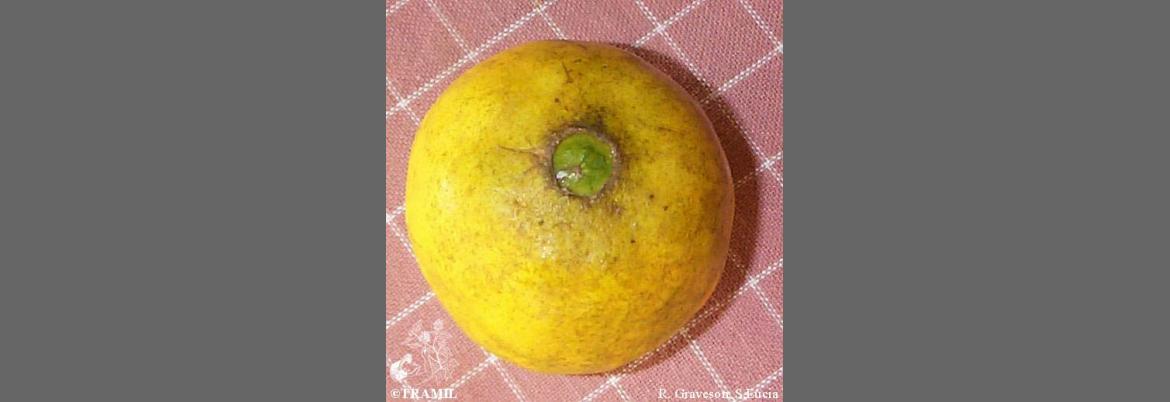1 WENIGER B, ROUZIER M, 1986 Enquête TRAMIL. Service Oecuménique d'Entraide SOE, Port au Prince, Haïti.
2 WENIGER B, 1987-88 Encuesta TRAMIL. enda-caribe, Santo Domingo, Rep. Dominicana.
3 WHO, 1991 Pautas para la evaluación de medicamentos herbarios WHO/TRM/91.4 (original inglés). Programa de Medicina Tradicional, OMS, Ginebra, Suiza.
4 STEWART I, 1985 Identification of caffeine in Citrus flowers and leaves. J Agric Food Chem 33(6):1163-1165.
5 NICO KJ, CHANDLER BV, 1978 Roots as a probable site for Citrus limonoid biosynthesis. Proc Int Soc Citric. p40-42.
6 ABDEL-ALIM MA, ABDEL-HAFEZ OM, EL-KHRISY AM, 1990 The constituents of Citrus sinensis leaves. Fitoterapia 61(5):470-471.
7 SHAFT N, IKRAM M, 1982 Quantitative survey of rutin-containing plants. Part 1. Int J Crude Drug Res 20(4):183-186.
8 EKUNDAYO O, BAKARE O, ADESOMOIU A, STAHL-BISKUP E, 1990 Nigerian sweet orange leaf oil composition. J Essent Oil Res 2(5):199-201.
9 GUANGHAN L, YU W, LEIMING Y, SHUANGLONG H, 1994 Determination of ascorbic acid in fruits and vegetables by stripping voltammetry on a glassy carbon electrode. Food Chem 51:237-239.
10 RADFORD T, KAWASHIMA K, FRIEDEL PK, POPE LE, GIANTURCO MA, 1975 Distribution of volatile compounds between the pulp and serum of some fruit juices. J Agric Food Chem 22(6):1066.
11 ROUSEFF RL, SEETHARAMAN K, NAIM M, NAGY S, ZEHAVI U, 1992 Improved HPLC determination of hydroxycinnamic acids in orange juice using solvents containing thf. J Agric Food Chem 40(7):1139-1143.
12 SWATSITANG P, TUCKER G, ROBARDS K, JARDINE D, 2000 Isolation and identification of phenolic compounds in Citrus sinensis. Anal Chim Acta 417(2):231-240.
13 OOGHE WC, OOGHE SJ, DETAVERNIER M, HUYGHEBAERT A, 1995 Characterization of orange juice (Citrus sinensis) by polymethoxylated flavones. J Agric Food Chem 42(10):2191-2195.
14 OOGHE WC, DETAVERNIER CM, 1999 Flavonoids as authenticity markers for Citrus sinensis juice. Fruit Process 9(8):308-313.
15 WIDMER WW, 2000 Determination of naringin and neohesperidin in orange juice by liquid chromatography with UV detection to detect the presence grapefruit juice: collaborative study. J Assoc Offic Anal Chem Int 83(5):1155-1165.
16 GROSS J, CARMON M, LIFSHITZ A, SKLARZ B, 1975 Structural elucidation of some orange juice carotenoids. Phytochemistry 14:249-252.
17 NOGATA Y, YOZA KI, KUSUMOTO KI, KOHYAMA N, SEKIYA K, OHTA H, 1996 Screening for inhibitory activity of Citrus fruit extracts against platelet cyclooxygenase and lipoxygenase. J Agric Food Chem 44(3):725-729.
18 TROVATO A, FORESTIERI A, GALATI EM, TUMINO G, 1988 Effects of the juice of certain species of Citrus on plasma and urinary uric acid levels in rats on a hyperpurinic diet. Plant Med Phytother 22(2):92-97.
19 KONOWALCHUK J, SPEIRS JI, 1978 Antiviral effect of commercial juices and beverages. Appl Environ Microbiol 35(6):1219-1220.
20 PEREZ C, ANESINI C, 1994 In vitro antibacterial activity of Argentine folk medicinal plants against Salmonella typhi. J Ethnopharmacol 44(1):41-46.
21 TROVATO A, FORESTIERI AM, GALATI EM, TUMINO G, 1984 Influence of the fruit juice of several Citrus species on steroidogenesis in the rat. Plant Med Phytother 18(1):8-14.
22 TROVATO A, MONFORTE MT, BARBERA R, ROSSITTO A, GALATI EM,
FORESTIERI AM, 1996 Effects of fruit juices of Citrus sinensis L. and Citrus limon L. on experimental hypercholesterolemia in the rat. Phytomedicine 2(3):221-227.
23 KUROWSKA EM, BORRADAILE NM, SPENCE JD, CARROLL KK, 2000 Hypocholesterolemic effects of dietary Citrus juices in rabbits. Nutr Res 29(1):121-129.
24 HONG ND, KIM JW, KIM BW, SHON JG, 1982 Studies on the efficacy of the combined preparation of crude drugs. VI. Effect of “Saengkankunbi-Tang” on activities of the liver enzyme, protein contents and the excretory on bile juice in the serum of CCl4-intoxicated rabbits. Korean J Pharmacog 13:33-38.
25 GOTO M, INOUE H, SEYAMA Y, YAMASHITA S, INOUE O, YUMIOKA E., 1989 Comparative effect of traditional Chinese medicines (Dai-Saiko To, Hatimi-Ziogan and Byakko-Ka-Ninzin-To) on experimental diabetes and hyperlipidemia. Nippon Yakugaku Zasshi 93(3):179-186.
26 KAWAKAMI M, SUZUKI K, ISHIZUKA T, HIDAKA T, MATSUKI Y, NAKAMURA H, 1998 Effect of grapefruit juice on pharmacokinetics of itraconazole in healthy subjects. Int J Clin Pharmacol Ther 36(6):306-308.
27 ADESINA SK, 1982 Studies on some plants used as anticonvulsants in Amerindian and African traditional medicine. Fitoterapia 53:147-162.
28 GUPTA M, 1987 Essential oil: a new source of bee repellents. Chem Ind (London) 5:161-163.
29 BEZANGER-BEAUQUESNE L, PINKAS M, TORCK M, 1986 Les plantes dans la thérapeutique moderne. 2 éd. Paris, France: Ed. Maloine.
30 HARTMAN JG, LIMBIRD ILE, Eds., 1996 Goodman & Gilman, Las bases farmacológicas de la Terapéutica, 9ª edición. México, México: McGraw-Hill Editores. p1670-1671.
31 MIYAGI Y, OM AS, CHEE KM, BENNINK MR, 2000 Inhibition of azoxymethane-induced colon cancer by orange juice. Nutr Cancer 36(2):224-229.
32 BALA S, GROVER IS, 1989 Antimutagenicity of some Citrus fruits in Salmonella typhimurium. Mutat Res 222(3):141-148.
33 PORTAL JA, RAMOS A, VIZOSO A, BETANCOURT J, 1995 Estudio genotóxico in vitro de una tintura al 50 % de Citrus sinensis (L.) Osbeck. Medi Ciego 1(1):3-6.
34 PORTAL JA, 1995 Evaluación genotóxica in vitro e in vivo de una tintura al 50% de Citrus sinensis (L.) Osbeck (Tesis de Maestría). Universidad Médica de La Habana, La Habana, Cuba.
35 PELLECUER J, 1995 Aromaterapia y toxicidad de los aceites esenciales. Natura Medicatrix 37(8):36-40.
36 CANIGUERAL S, VILA R, RISCO E, PEREZ F, PORTILLO A, FREIXA B, MILO B, VANACLOCHA B, RIOS JL, MORALES MA, ALONSO JR, BACHILLER LI, PERIS JB, STUBING G, 2002 Citrus sinensis. Vademecum de Fitoterapia, Editorial Masson, Barcelona, España, Jul.20,2002. URL: http://www.masson.es/book/fitoterapia.html
37 PAZOS L, COTO T, CAIZA F, 2008
Toxicidad oral aguda, dosis repetida, en ratón, de hojas frescas de Citrus sinensis. Informe TRAMIL. Laboratorio de Ensayos Biológicos, LEBi, Universidad de Costa Rica, San Pedro, Costa Rica.
38 PAZOS L, COTO T, REYES L, 2007 Tránsito Intestinal en ratones, del jugo fresco del fruto de Citrus sinensis. Informe TRAMIL. Laboratorio de Ensayos Biológicos, LEBi, Universidad de Costa Rica, San Pedro, Costa Rica.
39 PAZOS L, COTO T, REYES L, 2007 Irritación ocular, en conejos, del jugo fresco del fruto de Citrus sinensis. Informe TRAMIL. Laboratorio de Ensayos Biológicos, LEBi, Universidad de Costa Rica, San Pedro, Costa Rica.
















